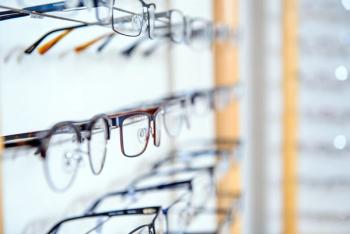
Providing eye care in Ukraine
Patients were eager for their free eye care, and they crowded around the doors to our clinics, making entrance into the clinics a near impossible task; however, 2,693 patients were cared for in our five days of clinics.
Dr. Omar with a patient in UkraineIt was an interesting team of 26 members-including 10 optometrists coming from many areas of the U.S., Canada, and Belgium-that met in Budapest, Hungary, to work together to provide eye care for the underserved. Members ranged in age from 16 to 70+. The VOSH-Ohio team then traveled to Beregovo, Ukraine, for its mission; the last VOSH mission into that area was in 1999. Sharing America’s Resources Abroad (SARA) was our host.
Our contact for this mission was the Rev. Dr. David Pandy-Szekeres. David is an authorized missionary of the Presbyterian Church of Canada and is directing the Mission to Roma Communities in Transcarpathia. He speaks fluent English, Hungarian, and French and has been awarded a diplomatic passport, which affords him rapid access to border crossing and custom inspections.
Getting across the border into the Ukraine takes quite a period of time because we passed through three points of review with our passports. Once inside Ukraine, we worked with the Hungarian Reformed Church. We found that most patients spoke Hungarian even though they live in the Ukraine. Road signs for towns are posted in Hungarian and Ukrainian. The border between the two countries had been moved at one time, and the area we were in was previously ruled by the Austro-Hungarian empire for more than 100 years.
Caring for patients in Ukraine
Patients were eager for their free eye care, and they crowded around the doors to our clinics, making entrance into the clinics a near impossible task; however, 2,693 patients were cared for in our five days of clinics.
The team encountered several interesting cases. We saw many cataracts, dry eye cases, and assorted strabismus conditions. Each exam required an interpreter for queries to/from the patient, which entailed considerable additional time for each exam. Many people had never been seen by a doctor of any kind. To pay for an eye exam and glasses from a local provider would typically cost about six weeks of wages, so most just went without. Otherwise, they would have had to go hungry.
Phoenix runs the autorefractor An optometrist from Belgium, Dr. Omar, was a great asset to the team. He successfully removed a foreign body from a patient’s eye using a business card and no anesthesia. He then flooded the eye with antibiotic solution. The patient was happy the eye no longer caused him pain.
A family came into our clinic with copies of MRI slides showing a growth behind the eye of their young son. His eye was bulging, which prompted the investigation. The family was hesitant to proceed with surgery and wanted a second opinion. We were fortunate to have a neurologist from Seattle as a team member, and he was brought in to evaluate the MRI slides. His recommendation was to proceed with the surgery because no other option was available.
We found that most patients preferred two pairs of glasses vs. bifocals. Our supply of glasses held out rather well; however, we did have a few pairs of glasses made for patients in the Ukraine because our inventory was not capable of providing some specific Rxs.
Our youngest member, Phoenix, a Canadian senior in high school, was quite a trooper. He came on the trip with his mother, who is an optician. He ran the autorefractor most of the time, a task that can be quite tiring. The stamina of youth is something to be desired.
Roads in the Ukraine are full of potholes, making travel rather slow. We held clinics two days in Beregovo and then traveled to outlying villages for the next three days for our clinics. We had to turn away some patients at each location due to the large crowds.
Life in Ukraine
After long hours in the clinic, the churches provided travel back to dorms provided by the church, sharing a coed bathroom. The churches also provided wonderful meals. We loved the cabbage rolls, golden mashed potatoes, and pork schnitzel. Pickles and tomatoes were plentiful for every meal. Patients brought candy and other gifts to the clinic to express their thanks.
After clinic on our last night, we visited an orphanage for girls which was established 20 years ago by the Reformed Church. The girls were aware that our team was to visit, so they prepared a program of songs and a Hungarian dance. This orphanage holds 75 to 80 girls, most of whom are handicapped. A few of these girls have moved out and into marriage; however, many have not. The church is dedicating a “care house” for the girls over 18 years of age as they will continue to live in a protected environment for the rest of their lives. This was a great closure for the team as we finished our mission work for the people of Ukraine.
Newsletter
Want more insights like this? Subscribe to Optometry Times and get clinical pearls and practice tips delivered straight to your inbox.


















































.png)


